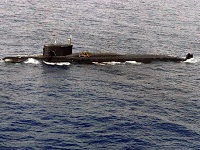K-219: The sub that scared Reagan and Gorbachev
On October 6, 1986, Soviet nuclear submarine K-219 sank in the Sargasso Sea in the infamous Bermuda Triangle. This was a severe loss for the Navy of the USSR. It is comparable only to the disaster of the Kursk nuclear submarine in the contemporary Russian history. In addition, it was very bad timing before the meeting of Reagan and Gorbachev.

The K-219 was a Soviet nuclear strategic submarine. On September 3, 1986, the K-219 came out of the home port of Gadzhievo and headed west to the coast of the U.S. where she had to patrol the area with 15 nuclear missiles on board. The commander of the cruiser in its last trip was an experienced submariner Igor Britanovs.
On October 3, 1986, an explosion of a ballistic missile in one of the silos of the boat has occurred. Three days later, on October 6, the boat sank in the Atlantic Ocean at a depth of 5,500 meters. Most of the crew was rescued.
The cause of the accident that started on October 3 and lasted for several days was an explosion in the missile silo, but some of the circumstances of this incident are still puzzling and disputed among experts.
The accident began with a "squashed" rockets and leaks of toxic rocket fuel into the bay. As a result of experimental tests, simulations and careful analysis, it was demonstrated that this was not the fault of the crew. Hence, the reasons were either purely technical or were caused by the external factors.
Why was the rocket crushed? How did the water get into the body of the missile silo? The official records have pictures that confirm that the hull of K-219 had a deep furrow, and it was the furrow that broke the seal of the silo. The question is, who rammed the boat? Was the "external factor" a foreign submarine?
As always, there are two theories of the events: the official one and unofficial one. According to the unofficial theory, the submarine accident was caused by an unidentified underwater object.
They say that experienced sailors are quite serious about the talks of "unidentified objects". According to a sailor Tushin, a proponent of this theory, he, like many submarine commanders, saw glowing balls and cylinders in the ocean. Almost every submariner has a story, but not many talk about them. In addition, meetings with such objects were not recorded by technical devices.
Captain Tushin was confident that the K-219 was sank by a mysterious force, but at the time it was not said out loud, so the "anomalous" theory was made public only years after the disaster.
The submariners of the Soviet Union and Russia remember about the heroic deed of an officer of the reactor compartment Belikov and 20-year-old sailor Sergei Preminin, who entered the reactor chamber to manually lower the compensation grid. The temperature in the chamber has reached 70C degrees. Before falling unconscious, Belikov was able to drop three of four compensatory grids.
Preminin had to enter the chamber twice before he could move the last, fourth grid. Melting of the reactor core was prevented. But neither Preminin nor the sailors were able to skew the heat compartment hatch separating the reactor chamber and control room.
Preminin died from the heat in the chamber, and the sailors were forced to retreat far in the back as the boat continued to get filled with poisonous orange gas. Preminin posthumously was awarded the Order of the Red Star for averting a nuclear accident in the Gulf Stream at the cost of his life. In 1997 Preminin was posthumously awarded the title of Hero of the Russian Federation.
Sometime later the refloated K-219 made contact with the Soviet commercial ships nearest to the scene of the tragedy. Due to the continuing spread of poisonous gas aboard K-219, it was decided to evacuate the crew to the ship "Anatoly Vasiliev." Commander Britanov was the only one left on board the submarine.
On October 6 an order from Moscow followed: "Duetotheimpossibilityof further towing, the crew must get on the boat and follow its course to the nearest port of the Soviet Union." However, early in the morning, before the order was announced, K-219 disappeared from the surface of the ocean, taking to the depths of the sea 14 nuclear missiles and two nuclear reactors.
Back in the Soviet Union, commander Britanov was awaiting trial in his hometown Sverdlovsk until May of 1987, but the new Minister of Defense Dmitry Yazov acquitted him of all charges. However, Britanov was dismissed from the Navy.
Incidentally, this was the first time that the Soviet Union has made an official public announcement of a disaster on board a warship. This was an era of glasnost. Both the United States and the Soviet government on October 3 made official statements about the incident. In addition, representatives of the U.S. Navy called a press conference at which the map of the accident was presented. The military of the two countries said that the danger of a nuclear explosion or leakage of radioactive substances did not exist. On October 4, 1986 TASS reported:
"In the morning of October 3, a fire broke out in one of the compartments of the Soviet nuclear submarine carrying ballistic missiles in the region about 1,000 kilometers north-east of Bermuda. The crew of the submarine and the Soviet ships that were nearby are fighting the fire. Three people were killed. The commission concluded that there is no risk of tampering weapons, nuclear explosions and radioactive contamination of the environment."
The time of the accident was politically very difficult. Therefore, both sides have tried to refrain from mutual accusations - a different situation compared to the collapse of the Soviet K-129 boat in 1968, and later - after the loss of "Kursk" in 2000. The cause for mutual restraint after the death of K-219 was the preparation to the meeting of Ronald Reagan and Mikhail Gorbachev on October 11-12, 1986 in Iceland.
Gorbachev clearly worried about the prospect of a conversation with Reagan about the Russian nuclear submarine with two nuclear reactors and ballistic missiles that sank off the coast of the United States. The talks touched on issues of deployment of medium-range missiles in Europe. Fortunately, Reagan seemed to have forgotten about the lost Soviet submarine and missiles in Europe were more important.
The main theory that Soviet sailors preferred was that the K-219 drowned because of a collision with an American submarine "Augusta."
Later representatives of the U.S. Navy issued a statement saying that the U.S. Navy rejected all the accusations that any American submarine collided with a Russian submarine K-219.
What is going on at the place of death of the Soviet nuclear submarine K-219 now? Retired professor Ivan T. Lavrushin answered this question for "Pravda.Ru:"
"Now the K-219 wreckage is sitting at the depth of five and a half miles. In 1986 and 1987 the Soviet Institute of the Sea sent a deep-water unit with a camera to the remnants of the boat. Hundreds of photos were taken that to this day are classified as "Top Secret."
Based on the fact that 30 nuclear warheads were located on board at the time of the disaster, it can be assumed that, in total, it is about 91 pounds of highly radioactive materials. We also know that at the bottom small traces of radioactivity were found."
The Washington Post wrote a few years after the accident that the U.S. Navy experts have come to the conclusion that the captain and the crew of the submarine deserved the highest praise for being able to quickly emerge, as well as the response to the fire. A film dedicated to the heroic dead of Preminin and Belikov, as well as the courage of the crew of K-219, was shot in the U.S.
Andrey Mikhailov
Pravda.Ru
Subscribe to Pravda.Ru Telegram channel, Facebook, RSS!





